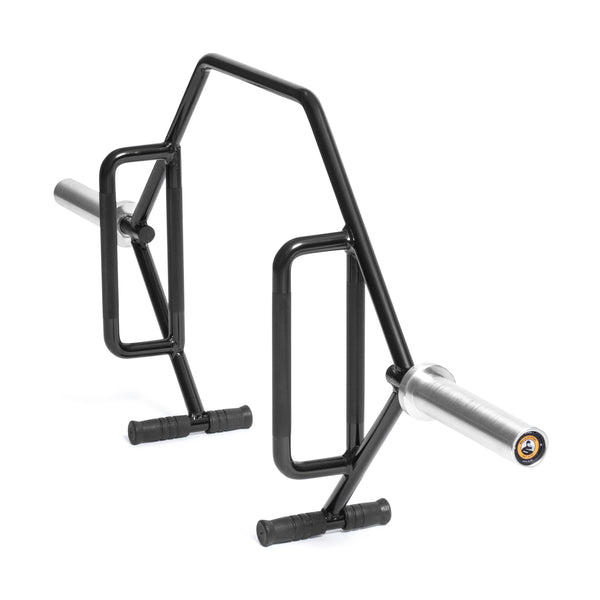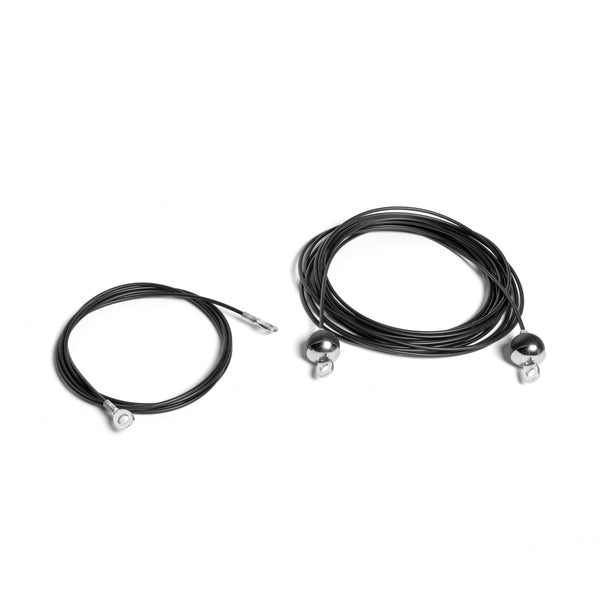If you're a weightlifting enthusiast, you've probably come across the hex bar, also known as the trap bar. This peculiar-looking piece of equipment is a staple in many gyms, and for good reason. But the question on everyone's mind is, can you squat with a hex bar? Let's dive in and find out.
What is a Hex Bar?

Before we get into the nitty-gritty of whether you can squat with a hex bar or not, let's first understand what this magical piece of equipment is.
A hex bar is a specialty barbell that has a hexagonal shape, hence its name (creativity was short that day). It’s designed to be lifted from the inside of the hexagon, giving you a more natural grip and neutral wrist position.
Hex bars are often also called trap bars— and for good reason.
The term "trap bar" comes from the fact that this type of bar was originally designed to help powerlifters and weightlifters train their trapezius muscles more effectively. The trapezius muscles, or "traps," are located in the upper back and neck area and are responsible for shrugging the shoulders and supporting the neck and head.
It could also be that the lifters misidentified the shape as a trapezoid. As we all know, brains are important, but gainz are important-er. 🤣
Trap/hex bars are commonly used for deadlifts but are versatile enough to perform various exercises.
Can You Squat with a Hex Bar?
The short answer is yes, you can squat with a hex bar. Squatting with a hex bar is a variation of the traditional squat that can provide many benefits. Here are some reasons why you might want to consider squatting with a hex bar:
- A hex bar squat is less stressful on your lower back than a traditional barbell squat— you won’t be loading your spine, similar to using a Belt Squat Machine.
- Hex bar squats allow you to maintain a more upright torso position, making it easier to target your quadriceps.
- Hex bar squats are great for people with mobility issues or those who struggle with proper squat form.
The difference between squatting and deadlifting with a hex bar are pretty subtle, but once you see it in action, you get the difference. Let’s explore the nuance between these movements.
The Difference Between Squatting and Deadlifting with a Hex Bar
Now that we know you can squat with a hex bar, let's differentiate between squatting and deadlifting with a hex bar. Although the two exercises may seem similar, they target different muscle groups and have different movement patterns.
The difference ultimately comes down to a slight change in hip positioning and knee flexion. With a hex bar deadlift, you’ll keep your hips high as you would with a traditional deadlift. With a hex bar squat, you’ll sink down and bend the knees as though you’re getting into a seated position.
You can also stand on some bumper plates or Stackable Pull Blocks to increase your range of motion and really push the squat movement or flip your hex bar over and grab the inner rails of the hex bar rather than the elevated handles.
See the hex bar squat in action here:
How to Do Hex Bar Squats
How to Do Hex Bar Squats:
- Place your feet hip-width apart in the center of the hex bar and grip the handles.
- Hinge back and lower into a squat position with your thighs parallel to the floor and your chest upright.
- Push through your heels to stand up, fully extending your hips and knees.
- Reverse the movement.
- Repeat for the desired number of reps.
Other Exercises You Can Do with an Open Hex Bar
Squatting and deadlifting with a hex bar are not the only exercises you can do with this versatile piece of equipment. The Bells of Steel Open Trap Bar / Hex Bar 3.0 has a unique open-faced design you’ll love. It’s like the hot turkey sandwich of the lifting world.
Here are some other exercises you can try with an open trap bar:
- Farmer's Walk: This exercise involves holding the hex bar with heavy weights and walking a certain distance. It helps strengthen your grip, core, and leg muscles. Grab the bar by the handles and go for a walk.
- Bent-Over Rows: Holding the bar with an overhand grip, bend forward at the waist and lift the bar towards your stomach to target your back muscles.
- Walking lunges: Hold the trap bar with both hands and step forward with one foot into a lunge position. Push off with your front foot and step forward with your other foot into a lunge position. Repeat for the desired number of reps.
- Reverse lunges: Stand with your feet hip-width apart and hold the trap bar with both hands. Step back with one foot into a lunge position, lowering your body until your front thigh is parallel to the floor. Push off with your back foot and return to the starting position. Repeat on the other side.
- Split squats: Stand with your feet hip-width apart and place one foot behind you on a bench or box. Hold the trap bar with both hands and lower your body until your front thigh is parallel to the floor. Push through your front foot to return to the starting position. Repeat on the other side.
- Overhead presses: Stand with your feet hip-width apart and hold the trap bar at shoulder height with your palms facing forward. Press the bar overhead until your arms are fully extended. Lower the bar back down to your shoulders and repeat for the desired number of reps.
The options are endless. If you get creative, remember to tag us on Instagram to be featured! So, can you squat with a hex bar? Absolutely!
Final Thoughts
Not only is it a great variation to the traditional barbell squat, but it also has many benefits. However, it's essential to understand the difference between squatting and deadlifting with a hex bar to ensure you're targeting the right muscle groups. With its versatility, a hex bar can be a great addition to your workout routine, so give it a try!



